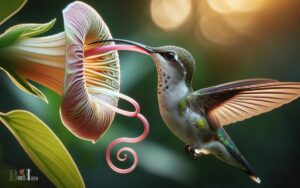Can You Use Apple Cider Vinegar to Clean Hummingbird Feeder?
Yes, apple cider vinegar can be used to clean a hummingbird feeder.
It is a natural and effective solution for eliminating mold, bacteria, and mineral buildup, ensuring a safe feeding environment for hummingbirds.
Apple cider vinegar is a natural disinfectant that is less harsh than bleach and can be used safely to clean hummingbird feeders.
The acidic properties of vinegar make it effective in killing germs and preventing the growth of mold and bacteria, which can be harmful to hummingbirds.
To use apple cider vinegar for cleaning:
- Mix one part apple cider vinegar with four parts water.
- Disassemble the hummingbird feeder completely.
- Soak all parts in the vinegar solution for an hour.
- Scrub the feeder with a brush to remove any remaining debris.
- Rinse thoroughly with water to ensure no vinegar taste is left behind.
- Allow the feeder to air dry completely before refilling with nectar.
Employ apple cider vinegar for a safe and eco-friendly approach to keeping your hummingbird feeders pristine and welcoming.

Key Takeaway
Benefits of Apple Cider Vinegar
Apple cider vinegar has been valued for its numerous health and cleaning benefits for centuries.
It is renowned for its natural antibacterial and antiseptic properties, making it an ideal cleaning agent for various household items, including hummingbird feeders.
Apple cider vinegar can be a useful and natural cleaning agent for hummingbird feeders.
Here are some potential benefits:
Natural Antimicrobial Properties
Apple cider vinegar has mild antimicrobial properties, which can help kill bacteria, fungi, and other microorganisms that may contaminate the hummingbird feeder.
This can prevent the growth of harmful pathogens that could be detrimental to the health of hummingbirds.
Gentle and Non-Toxic
Apple cider vinegar is a natural substance and is generally safe for the environment. Using it to clean hummingbird feeders avoids the use of harsh chemicals that could be harmful to the birds or the environment.
Removal of Residue
Over time, sugar water can leave a sticky residue on the inside of the feeder. Apple cider vinegar can help dissolve and remove this residue effectively.
Odor Neutralization
Apple cider vinegar has a natural ability to neutralize odors. If there is any unpleasant smell in the hummingbird feeder, cleaning it with apple cider vinegar can help eliminate the odor.
Prevention of Mold and Mildew
Hummingbird feeders can be prone to mold and mildew growth, especially in warm and humid conditions.
Apple cider vinegar’s antimicrobial properties can help prevent the formation of mold and mildew.
Proper Feeder Disassembly
When disassembling a hummingbird feeder for cleaning, it’s important to carefully remove each part to ensure thorough cleaning.
Separating the feeder components allows for a more effective cleaning process, ensuring that no part is overlooked.
Proper disassembly also enables easier access to hard-to-reach areas, helping to maintain the feeder’s functionality and attractiveness to hummingbirds.
Feeder Part Removal
The removal of feeder parts must be done with care and precision to ensure proper disassembly for cleaning.
Here are some important tips for disassembling a hummingbird feeder:
Initial Inspection
Before beginning the disassembly process, carefully inspect the feeder for any visible damage or wear and tear. This will help prevent any potential mishaps during the removal of parts.
Follow Manufacturer’s Instructions
Always refer to the manufacturer’s guidelines for disassembly. Some feeders may have specific instructions or components that require special attention during removal.
Proper disassembly is crucial for effective cleaning and maintenance, ensuring that all parts are thoroughly cleaned and the feeder is safe for the hummingbirds to use.
Component Separation for Cleaning
Proper disassembly of the hummingbird feeder’s components is essential for thorough cleaning and maintenance. When separating the feeder’s parts, it’s important to handle each component with care to avoid damage.
Disassembling for Thorough Cleaning
To ensure thorough cleaning of the hummingbird feeder, it is essential to properly disassemble its components, maintaining care to avoid damage and ensuring effective maintenance.
When disassembling the hummingbird feeder, follow these steps:
Remove the Perches and Ports:
- Gently twist and pull the perches and ports from the feeder base.
- Inspect the perches and ports for any signs of wear or debris buildup.
Separate the Base and Reservoir:
- Unscrew the base from the reservoir and carefully set them apart.
- Check for any leftover nectar or mold in the crevices that may require thorough cleaning.
Proper disassembly allows for a more meticulous cleaning process, ensuring the hummingbird feeder remains a safe and welcoming spot for these delightful birds.
Soaking and Scrubbing Techniques
One effective method for cleaning a hummingbird feeder involves soaking it in a solution of apple cider vinegar and water, followed by gentle scrubbing to remove any remaining residue.
This technique helps to effectively eliminate mold, bacteria, and other contaminants that can be harmful to the hummingbirds.
The soaking and scrubbing process ensures that the feeder is thoroughly cleaned and ready for refilling, thus providing a safe and healthy environment for the hummingbirds.
| Step | Instructions | Purpose |
|---|---|---|
| 1 | Disassemble the feeder and soak it in a solution of one part apple cider vinegar to four parts water for 30 minutes. | The vinegar solution helps to break down and loosen any debris or residue. |
| 2 | Gently scrub the feeder with a bottle brush or sponge to remove any remaining buildup. | Scrubbing ensures that all contaminants are removed, leaving the feeder clean and safe for the hummingbirds. |
| 3 | Rinse the feeder thoroughly with clean water before allowing it to air dry completely. | Rinsing removes any lingering vinegar and ensures that the feeder is ready for use. |
Drying and Reassembly Process
After allowing the feeder to air dry completely, carefully reassemble its components to ensure proper functionality and cleanliness.
Here’s a helpful guide for the drying and reassembly process:
- Gently pat each component with a clean, dry cloth to remove any remaining moisture.
- Place the parts in a well-ventilated area for thorough drying, ensuring there is no moisture trapped in any crevices.
Following these steps will help maintain the cleanliness and functionality of your hummingbird feeder, ensuring a safe and welcoming environment for these delightful creatures.
Frequency of Cleaning
Once a week, thoroughly clean the hummingbird feeder to ensure a safe and hygienic environment for the birds.
Regular cleaning helps prevent the growth of mold, bacteria, and other contaminants that could harm the delicate hummingbirds.
Here’s a simple table to help you keep track of the cleaning schedule:
Regular cleaning is crucial to maintain a healthy and safe environment for hummingbirds.
| Frequency | Instructions |
|---|---|
| Daily | Check Nectar Level: Monitor nectar levels and refill as needed. Clean if you notice any signs of spoilage. |
| Every 2-3 Days | Rinse and Refill: Empty, rinse, and refill the feeder every 2-3 days, especially in warmer weather. This prevents fermentation and bacterial growth. |
| Weekly | Thorough Cleaning: Disassemble the feeder, soak in a vinegar solution for 30 minutes, scrub, rinse, and air dry. Inspect for any damage. |
| Monthly | Deep Clean: Conduct a more extensive cleaning, examining all parts for wear and tear. Replace any damaged components. |
Is Apple Cider Vinegar Safe for Cleaning Hummingbird Feeders?
Apple cider vinegar is a safe and effective option for cleaning hummingbird feeders. Its acidity helps remove mold and bacteria while being non-toxic for the birds. Diluting it in water and scrubbing the feeder with a brush is recommended. Remember, though, humans can drink hummingbird nectar, not vinegar!
Additional Tips and Considerations
To ensure the well-being of the hummingbirds, it is essential to consider additional tips and considerations for maintaining a healthy and hygienic environment around the feeder.
Feeder Placement
- Position the feeder in a shaded area to prevent the nectar from spoiling quickly due to direct sunlight exposure.
- Ensure the feeder is placed away from potential hazards such as windows, as collisions can be harmful to the hummingbirds.
Conclusion
Apple cider vinegar can be an effective and natural cleaning solution for hummingbird feeders. Regular cleaning of feeders is important to prevent the growth of harmful bacteria and mold.
According to a study by the National Audubon Society, it is recommended to clean hummingbird feeders at least once a week to maintain the health and well-being of the birds.
Using apple cider vinegar can help ensure a safe and clean environment for hummingbirds to feed.






